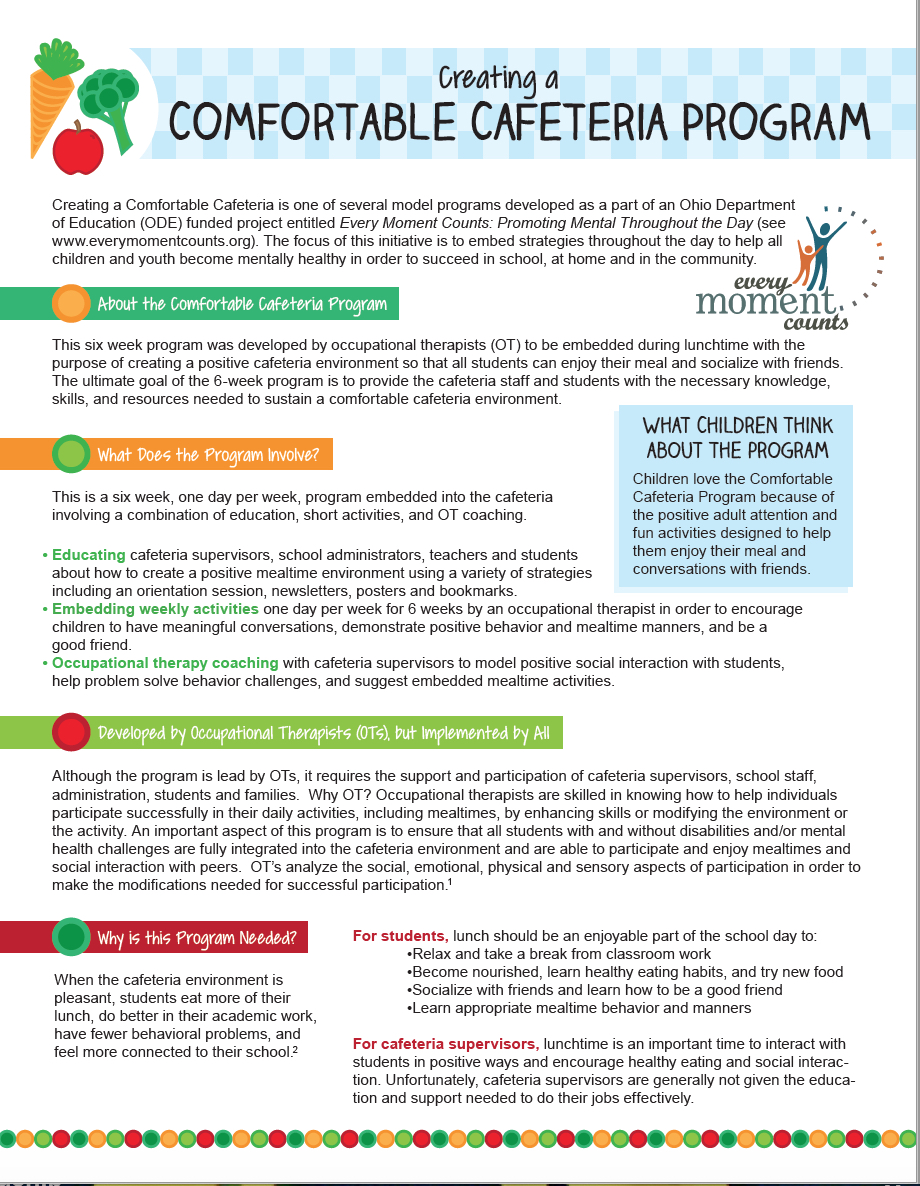Comfortable Cafeteria

Jump to a Section
Before You Dive In
On Demand Webinar
Promote positive participation and health during lunch and recess! Learn how to gear up for the Comfortable Cafeteria and Refreshing Recess program implementation with confidence.
Downloadable Materials
Use the following materials to learn about, market, and implement the Comfortable Cafeteria program:
INFORMATION BRIEF: Inform others about the program. Download and share the Information Brief below. (2 pages)
Comfortable Cafeteria POSTER, BOOKMARKS, and COLORING SHEET (click on images below to download)
Comfortable Cafeteria Frequently Asked Questions (FAQs)
COMFY CAFE′: Modifications for Middle School Students
(6 Information Sheets)
Check it Out! Comfortable Cafeteria Video Clips!
Video #1: Here's what the cafeteria supervisors, students, and a speech therapist have to say about the Comfortable Cafeteria program (3 minutes) Click on image below to download.

Video #2: Here's what occupational therapists have to say about the Comfortable Cafeteria program (3 minutes)

Video #3: Here's what a principal has to say about the Comfortable Cafeteria program (2 minutes)

Orientation PPT: This power point presentation can be used to provide an orientation to the Comfortable Cafeteria program for cafeteria supervisors, teachers, and the principal. (no audio)
Introduction

The Comfortable Cafeteria is one of several model programs developed as a part of Every Moment Counts. The focus is on embedding strategies to help all children and youth participate and enjoy eating lunch and socializing with friends and adults in the school cafeteria.
Time spent in the school cafeteria is an important part of the day for students to enjoy their meal, take a break from classroom work, and enjoy conversations with friends. When the school cafeteria environment is pleasant, students eat more of their lunch, do better in their academic work, have fewer behavioral problems, and feel more connected to their school.
The purpose of this program is to create a positive school cafeteria environment by providing the cafeteria staff and students with the necessary knowledge, skills, and resources needed to sustain a comfortable cafeteria throughout the school year.
Use the resources provided in this section of the website to help you:
- Learn about this program
- Hear what staff and students say about it (video clips)
- Learn how to implement the program – Just do it! Weekly Lesson Plan
- Download bookmarks, posters, and other materials for implementation
- Read about the research outcomes
Download and share a copy of the Comfortable Cafeteria Information Brief
Program developed by: Louise Demirjian, MA, OTR/L, Fran Horvath, OTR/L and Susan Bazyk, PhD, OTR/L (2014)
Vision Statement
Our school cafeteria will provide pleasant and positive mealtimes so that all students will enjoy eating food and socializing with friends and adults in the school cafeteria.
About the Program
 Based on an outcome study1 of implementation in several school districts, significant positive changes in student perceptions of their school cafeteria lunchtime experience after just 6 weeks were found, including improvements in:
Based on an outcome study1 of implementation in several school districts, significant positive changes in student perceptions of their school cafeteria lunchtime experience after just 6 weeks were found, including improvements in:
1) Experiencing lunchtime as enjoyable, especially in children that initially did not enjoy lunch
2) Thinking that other children are friendly
3) Perceiving school cafeteria supervisors as more friendly and helpful
4) Having enjoyable mealtime conversations
5) Cafeteria supervisors feeling more prepared to do their jobs based on what they learned during the program
Sustain it! Maintain a positive school cafeteria culture!
Following the 6-week program, it is our hope that school staff and students will commit to sustaining a positive school cafeteria environment by using the resources provided on this website.
1 Bazyk, S., Demirjian, L., Horvath, F., & Doxsey, L. (2018). The Comfortable Cafeteria program for promoting student participation and enjoyment: An outcome study. American Journal of Occupational Therapy, 74 (3), 1-9, https://doi.org/10.5014/ajot2018.02379
This is a 6-week, 1 day/week, program embedded into the cafeteria involving a combination of education, short activities, and coaching.
 Educating cafeteria supervisors, school administrators, teachers and students about how to create a positive mealtime environment using a variety of strategies including an orientation session, newsletters, posters and bookmarks.
Educating cafeteria supervisors, school administrators, teachers and students about how to create a positive mealtime environment using a variety of strategies including an orientation session, newsletters, posters and bookmarks.
Embedding weekly activities one day per week for 6 weeks by an occupational therapy practitioner and/or other school personnel (e.g. teachers, SLPs, school counselors, etc.) in order to encourage children to have meaningful conversations, demonstrate positive behavior and mealtime manners, and be a good friend.
Coaching with cafeteria supervisors to model positive social interaction with students, help problem solve behavior challenges, and suggest embedded mealtime activities.
Developed by OTs, but implemented by all!
Although the program was developed by occupational therapists, it can be implemented by any school professional who has a vested interest in improving the cafeteria experience.
The role of the program facilitator is one of change agent and educational enhancer – to assist cafeteria supervisors and students in learning how to promote a positive mealtime experience for all students.
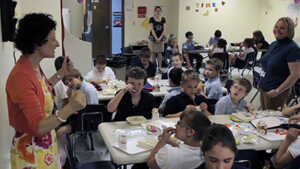 Why are OTs recommended for facilitating this program? Occupational therapy practitioners (OTs & OTAs) are skilled in knowing how to help individuals participate successfully in daily activities, including mealtimes, by enhancing skills or modifying the environment or the activity. Also, addressing eating, feeding, and mealtimes is a part of OT's scope of practice. An important aspect of this program is to ensure that all students with and without disabilities and/or mental health challenges are fully integrated into the cafeteria environment. We want all students to be able to participate in and enjoy lunch and social interaction with peers. OT’s are skilled in analyzing the social, emotional, physical and sensory aspects of participation in order to make the modifications needed for successful participation.1
Why are OTs recommended for facilitating this program? Occupational therapy practitioners (OTs & OTAs) are skilled in knowing how to help individuals participate successfully in daily activities, including mealtimes, by enhancing skills or modifying the environment or the activity. Also, addressing eating, feeding, and mealtimes is a part of OT's scope of practice. An important aspect of this program is to ensure that all students with and without disabilities and/or mental health challenges are fully integrated into the cafeteria environment. We want all students to be able to participate in and enjoy lunch and social interaction with peers. OT’s are skilled in analyzing the social, emotional, physical and sensory aspects of participation in order to make the modifications needed for successful participation.1
Who else can help provide this program?
- Cafeteria supervisors
- Food service personnel
- Parent volunteers
- Teachers – General and Special Educators
- Speech Language Pathologists (SLPs)
- Physical Education teachers and Health Educators
- School nurses
- School Counselors
- School Psychologists
- School social workers
Collaboration is essential! Implementation of the Comfortable Cafeteria program requires the support and participation of cafeteria supervisors, school staff, principals, students and families.
1 American Occupational Therapy Association (2013). The Cafeteria: Creating a Positive Mealtime Experience. See AOTA's School Mental Health toolkit at https://www.aota.org/Practice/Children-Youth/Mental%20Health/School-Mental-Health.aspx
When the cafeteria environment is pleasant, students eat more of their lunch, do better in their academic work, have fewer behavioral problems, and feel more connected to their school.1,2,3
For students, lunch should be an enjoyable part of the school day to:
- Relax and take a break from classroom work
- Become nourished, learn healthy eating habits, and try new food
- Socialize with friends and learn how to be a good friend1
- Learn appropriate mealtime behavior and manners
For cafeteria supervisors, lunchtime is an important time to interact with students in positive ways and encourage healthy eating and social interaction. Unfortunately, cafeteria supervisors are generally not given the education and support needed to do their jobs effectively. School principals need to strategically recruit, hire, and educate cafeteria supervisors who will interact in positive ways with all students and actively promote positive behavior.
1 Blum, R. (2005). School Connectedness: Improving the Lives of Students. Johns Hopkins Bloomberg School of Public Health, Baltimore, Maryland 2 Center for Ecoliteracy. (2010). Rethinking school lunch: A planning framework from the center of ecoliteracy. http://www.ecoliteracy.org/sites/default/files/uploads/rethinking_school_lunch_guide.pdf 3 American Institute for Research (AIR). (2021). Relationships (National Center on Safe and Supportive Learning Environments. https://safesupportivelearning.ed.gov/topic-research/engagement/relationships
 Tier 1, Universal: The Comfortable Cafeteria program is a universal, school-wide program with the goal of helping all students participate in and enjoy their lunch. Weekly themes emphasize prosocial skills and abilities such as, having a meaningful conversation, being a good friend, and eating healthy food.
Tier 1, Universal: The Comfortable Cafeteria program is a universal, school-wide program with the goal of helping all students participate in and enjoy their lunch. Weekly themes emphasize prosocial skills and abilities such as, having a meaningful conversation, being a good friend, and eating healthy food.
Tier 2, Targeted: There may be students who are at-risk of experiencing challenges in the cafeteria due to social, emotional, sensory, or physical challenges. During the cafeteria observation, it is critical for the program facilitators to tune-into students who may be struggling to participate and enjoy their lunch. For example, some students may have a difficult time with noise levels. Others might struggle socially in knowing how to make friends and fit in. Skilled program facilitators will provide the accommodations and supports needed to foster successful participation.
Tier 3, Individualized: Some students may have more significant challenges that may limit participation in the cafeteria (e.g. behavioral outbursts, aggressive behavior, etc.). The program facilitators will work with relevant school personnel to develop individualized strategies to foster positive behaviors and successful participation.
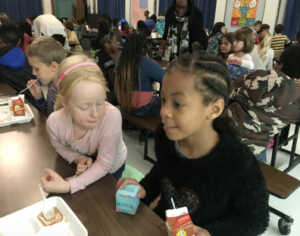 Vision Statement: Our school will provide pleasant and positive mealtimes so that all students will enjoy eating food and socializing with friends and adults.
Vision Statement: Our school will provide pleasant and positive mealtimes so that all students will enjoy eating food and socializing with friends and adults.
Guiding Principles1:
1) Create a positive mealtime environment, which includes having adequate time to eat (20 minutes of sit down time) and a cafeteria that is comfortable, attractive, clean and safe (physically & emotionally i.e. bully free).2
2) Provide recess before lunch. Studies indicate that students are more relaxed, better behaved, and eat more of their lunch when recess occurs prior to eating. Teachers report better student attention and behavior in the afternoon when students receive recess before lunch.3 However, due to scheduling issues, it may not be possible to have recess before lunch. If this is the case, it might be helpful to embed a short movement activity before transitioning to the cafeteria.
3) Create a positive social climate, by encouraging pleasant mealtime conversations and friendships. Emphasis is on creating an environment where all students, including those with varying abilities, feel welcomed, supported and respected.4
4) Promote healthy eating habits. Students learn about and have opportunities to eat healthy foods and develop healthy eating habits. Food is not used as a reward or punishment and students are not pressured to eat.5
1 Bazyk, S., Demirjian, L., Horvath, F., & Doxsey, L. (2018). The Comfortable Cafeteria program for promoting student participation and enjoyment: An outcome study. American Journal of Occupational Therapy, 74 (3), 1-9, https://doi.org/10.5014/ajot2018.02379 2 Center for Ecoliteracy. (2010). Rethinking school lunch: A planning framework from the center of ecoliteracy. https://www.ecoliteracy.org/sites/default/files/uploads/rethinking_school_lunch_guide.pdf 3 Robert Wood Johnson Foundation, (2010). State of play: Gallup survey of principals on school recess. https://www.rwjf.org/en/library/research/2010/02/the-state-of-play.html 4 Heyne, L., Wilkins, V., & Anderson, L. (2012). Social inclusion in the lunchroom and on the playground at school. Social Advocacy and Systems Change Journal, 3, 54-68. 5 Alliance for a Healthier Generation. (2014). Essential topics on healthy eating. https://www.healthiergeneration.org/take-action/schools/wellness-topics/health-physical-education/health-education/essential-topics-0
Development of the Comfortable Cafeteria program was based on current literature – information available from national organizations or technical assistance centers (e.g Center for Ecoliteracy) as well as published research studies.
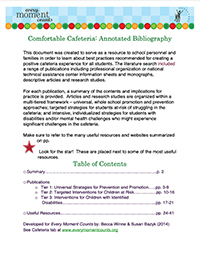 To learn more about issues surrounding school cafeterias (e.g. encouraging healthy eating, promoting positive social interaction), please download and read the Cafeteria Annotated Bibliography. This document also shares useful resources related to improving the cafeteria context – free, downloadable guides, newsletters, etc.
To learn more about issues surrounding school cafeterias (e.g. encouraging healthy eating, promoting positive social interaction), please download and read the Cafeteria Annotated Bibliography. This document also shares useful resources related to improving the cafeteria context – free, downloadable guides, newsletters, etc.
Research on the Comfortable Cafeteria program: Refer to 'Research Outcomes' below to learn about findings from a mixed methods study.1
Highly recommended website resources:
The Family Dinner Project 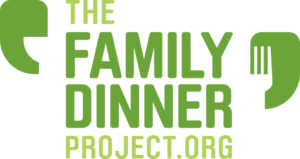 This website offers a variety of family-friendly information and ideas for making mealtimes meaningful. The Family Dinner Project is a nonprofit organization operating from the Project Zero offices at Harvard University described as a movement of 'food, fun, and conversation' in support of family meals. Tips for dinnertime conversation (e.g. explore challenging conversations, conversation starters) and ideas for family games and between dinner and dessert activities are provided.
This website offers a variety of family-friendly information and ideas for making mealtimes meaningful. The Family Dinner Project is a nonprofit organization operating from the Project Zero offices at Harvard University described as a movement of 'food, fun, and conversation' in support of family meals. Tips for dinnertime conversation (e.g. explore challenging conversations, conversation starters) and ideas for family games and between dinner and dessert activities are provided.
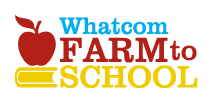 Whatcom Farm to School This website provides user-friendly resources on healthy eating and creating positive social and physical cafeteria environments.
Whatcom Farm to School This website provides user-friendly resources on healthy eating and creating positive social and physical cafeteria environments.
Reference:
1 Bazyk, S., Demirjian, L., Horvath, F., & Doxsey, L. (218). The Comfortable Cafeteria program for promoting student participation and enjoyment: An outcome study. American Journal of Occupational Therapy, 74 (3), 1-9, https://doi.org/10.5014/ajot2018.02379
10 Steps to Success in the School Cafeteria
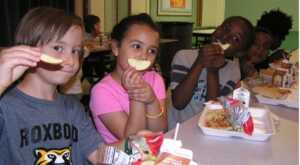 The 10 Steps described below help you gear up for and provide the program from start to finish.
The 10 Steps described below help you gear up for and provide the program from start to finish.
Based on our experience, there are
3 major phases involved in providing this program:
1) Gearing up to start the program (Steps 1 through 6; should take 2-4 weeks). These steps are not necessarily sequential - they are often pursued simultaneously. This phase involves the program facilitator(s) and other committed staff reading about school cafeteria best practices, meeting relevant stakeholders (cafeteria supervisors), developing a plan of action (e.g. beginning with one grade level), obtaining principal support, and selling/marketing the program to the school.
2) Doing it (Steps 7 and 8). Each of the 6 weeks has themed activities and instructions for implementation outlined in a lesson plan.
3) Sustaining the results and expanding to other grades in the school (Steps 9 and10).
Let’s get started! Click each step below for specific instructions and downloadable materials.
Spend some time reading about cafeteria best practices. Invite one or more colleagues to join you so that you can generate shared interest and a commitment to running this program. Key players include occupational therapists, health educators, speech therapists, school counselors, teachers, para-educators and school nurses.
Important information about best practices in the cafeteria is synthesized in the Comfortable Cafeteria Annotated Bibliography. Based on a comprehensive literature review of cafeteria best practices, this annotated bibliography provides a summary of current monographs, descriptive articles and research studies. Key 'take aways' include:
1) Have enough adult supervisors: Schools should aim for a 1 to 50 ratio of adults to students (e.g. a minimum of 2 supervisors for 100 students). We have found, however, that adult presence in the cafeteria makes a big difference in student behavior. Schools need to be creative in increasing the number of supervisors present - e.g. free lunches for teachers who eat in the cafeteria.
2) Provide education and support for cafeteria supervisors: Include OTs or other school personnel who have a vested interest in creating a positive cafeteria environment when interviewing potential cafeteria supervisors. Right from the start, convey how important it is for supervisors to be positive and take an interest in students. Provide an orientation to cafeteria supervisors on what 'active supervision' entails, such as 'working the crowd' (walking around and saying 'hi' to groups of students; making a point to learn one new name each day). Make sure rules and routines are established for behavior in the cafeteria and reinforced.
Other suggested reading:
Comfortable Cafeteria website material. Read the information in the About the Program section to learn the basics about the Comfortable Cafeteria program. Pay special attention to the Vision Statement & Guiding Principles as these provide an important foundation for the entire program.
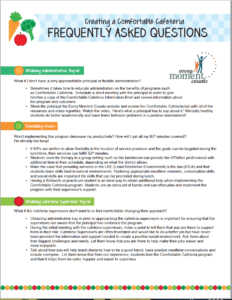
Comfortable Cafeteria Information Brief provides a 2-page overview of the program. Share this two-page document with colleagues who might be interested in helping you implement the program. For example, in one of our demonstration sites, the occupational therapist and speech therapist worked together to provide the program.
Comfortable Cafeteria FAQs (Frequently Asked Questions). This document provides user-friendly information related to implementing the Comfortable Cafeteria program.
Helpful websites:
The Family Dinner Project This  website offers a variety of family-friendly information and ideas for making mealtimes meaningful. The Family Dinner Project is a nonprofit organization operating from the Project Zero offices at Harvard University described as a movement of 'food, fun, and conversation' in support of family meals. Tips for dinnertime conversation (e.g. explore challenging conversations, conversation starters) and ideas for family games and between dinner and
website offers a variety of family-friendly information and ideas for making mealtimes meaningful. The Family Dinner Project is a nonprofit organization operating from the Project Zero offices at Harvard University described as a movement of 'food, fun, and conversation' in support of family meals. Tips for dinnertime conversation (e.g. explore challenging conversations, conversation starters) and ideas for family games and between dinner and  dessert activities are provided.
dessert activities are provided.
Whatcom Farm to School This website provides user-friendly resources on healthy eating and creating positive social and physical cafeteria environments.
Reference:
1 Bazyk, S., Demirjian, L., Horvath, F., & Doxsey, L. (2018). The Comfortable Cafeteria program for promoting student participation and enjoyment: An outcome study. American Journal of Occupational Therapy, 74 (3), 1-9, https://doi.org/10.5014/ajot2018.02379Observe lunchtime for the grade level that you plan to implement the program with. Complete the Comfortable Cafeteria Environmental Analysis form. This is a fillable form.
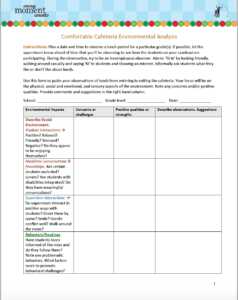 Before beginning the program, it is important to stop and observe the cafeteria environment and students' lunchtime experience in order to identify what's 'right' as well as what might need to be modified in order to make improvements. Every school and grade level within a school might have different challenges and needs.
Before beginning the program, it is important to stop and observe the cafeteria environment and students' lunchtime experience in order to identify what's 'right' as well as what might need to be modified in order to make improvements. Every school and grade level within a school might have different challenges and needs.
Action step: This observation can be completed in a short amount of time (~20-30 min.) by a skilled occupational therapist or other school personnel who have the ability to tune into the physical, social-emotional, and sensory aspects of the environment – each of which can influence the lunch experience in a positive or negative way. Let the cafeteria supervisors know that you'll be doing an informal observation to obtain preliminary information about the quality of the lunch experience. Reassure them that this is not being done to evaluate their performance. Use this time to start building a positive relationship with the supervisors. Obtain their input about what they perceive are strengths and challenges during lunch.
The Cafeteria Environmental Analysis involves observing the physical (layout, seating), sensory (auditory, visual, movement, an olfactory) and social-emotional aspects of the cafeteria experience. Determine what characteristics of the existing cafeteria environment contribute to successful participation and enjoyment for all students. Identify challenges and/or limitations. Consider what may need to be modified or changed both in terms of procedures (i.e. transitioning out of cafeteria after disposing of trash) as well as environmental modifications (table arrangements, placement of garbage cans, regulating noise levels, etc). Think about aspects of the social environment that might need improvements (e.g. ensuring that no students sit alone).
Summarize observations. Think about strategies for improvement.
As a part of gearing up to begin the Comfortable Cafeteria program, it is important for the program facilitators (e.g.occupational therapist and/or other school staff) to meet with 'relevant stakeholders' and begin to develop a positive, trusting relationship with them.
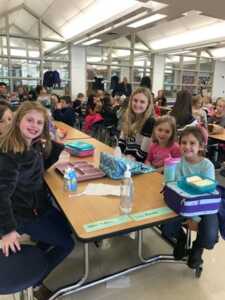 Relevant stakeholders include any person who has a vested interest in or may be impacted by the cafeteria program such as cafeteria supervisors, food service personnel, school custodians, teachers, and principal. All relevant stakeholders need to be informed about what the Comfortable Cafeteria program is and when it will take place.
Relevant stakeholders include any person who has a vested interest in or may be impacted by the cafeteria program such as cafeteria supervisors, food service personnel, school custodians, teachers, and principal. All relevant stakeholders need to be informed about what the Comfortable Cafeteria program is and when it will take place.
The most important stakeholders to collaborate with are the cafeteria supervisors. It's important to find out who is assigned to 'lunch duty' which varies from school to school. Although there may be variations in who actually serves in this capacity, cafeteria supervisors are the adults responsible for overseeing the lunch session and who help the students enter and leave the cafeteria, obtain lunches (if purchased), behave in positive ways, and enjoy their lunch. Cafeteria supervisors may be paid personnel (usually part-time), parent volunteers, or teachers assigned to 'lunch duty'.
Action step: The Comfortable Cafeteria program facilitators need to make a point of introducing themselves to the cafeteria supervisors during the observation session and share a copy of the Comfortable Cafeteria Information Brief.
Emphasize that the purpose of the program is to help support them in their role as supervisors by providing information, weekly activities, and ongoing problem-solving and coaching. Cafeteria supervisors play a critical role in helping students enjoy their school day. Reinforce their importance and commit to working with them in a collaborative manner.
Although the Comfortable Cafeteria program is designed to be a universal whole school initiative, we suggest starting small to ensure initial success. The program facilitators (e.g. OT and SLP) should meet to decide what grade level to begin with. It's best to begin any new program by working with stakeholders who show interest and enthusiasm in being involved. Our motto is, 'look for the open doors' and begin there since implementation involves collaboration with any staff member or volunteer assigned to lunch duty. We have had success beginning with 2nd, 3rd, or 4th graders and expanding to the other grades.
Action steps:
Pick a grade level. In our demonstration projects, we began with 2nd or 3rd graders since students at these ages are generally adjusted to school and can follow directions. Since the program only takes 6 weeks, it can be replicated numerous times throughout the school year with different grade levels.
Select a day of the week to implement the program. The program facilitators will be embedding their services into the cafeteria one day per week for 6 consecutive weeks to run the program. Choosing the specific day of the week should be a collaborative decision between the program facilitators and cafeteria supervisors. In most instances, this will depend on the program facilitators' schedule. A benefit of holding the program mid-week is that it allows cafeteria supervisors and teachers to introduce the weekly theme to students early in the week (e.g. verbally or with books or coloring sheets).
Time commitment. Based on our experience in implementing the program in multiple school districts, OTs report needing approximately 30 minutes of preparation time and 30 minutes for implementation each week. Many related service providers (OT, SLP, school counselors) have indicated that their time implementing the program can count toward IEP minutes or as a part of a workload model. Like any new program, the first time it is implemented will take more effort. We have observed many creative ways that school professionals have collaborated to provide the program. Likely facilitators include: OTs, SLPs, school counselors, special education teachers, general education teachers, and school nurses.
Following the 6th week, it is suggested that the program facilitators provide intermittent consultation and support by stopping in the cafeteria to offer ongoing problem solving and activity suggestions.
In order to implement the program, it is essential to obtain the school principal's permission and support. We have found principals to be very interested in this program because the cafeteria tends to be a place where higher incidents of behavioral problems occur leading to office referrals. Most schools, in our experience, do not have organized programs designed to prepare and support cafeteria supervisors and students in creating a positive cafeteria environment.
Action step:
Schedule an appointment to meet with the school principal to obtain permission and support. Before the meeting, give him/her a copy of the Comfortable Cafeteria Information Brief to read so that she/he can become familiar with the program. Encourage the principal to read about the Comfortable Cafeteria program on the Every Moment Counts' website and watch the video vignette 'Here's what a Principal says about it'.
During the meeting:
1. Give a brief review of the Comfortable Cafeteria program;
2. Summarize your observations of the cafeteria environment based on the Environmental Analysis. Discuss the strengths, needs, and your suggestions for improvement.
3. Share your plan of action for implementing the program (i.e. targeted grade level, day of the week, and date to begin).
4. Agree on when to begin the program and plan a date/time for the Orientation for cafeteria supervisors (need ~ 1 hour). The principal will coordinate with the cafeteria supervisors to arrange a time and location for the Orientation session. It is critical that the principal is 'on board' and communicates her/his commitment to the success of the Comfortable Cafeteria program.
After the principal has given an official approval to implement the Comfortable Cafeteria program, it is important to let the relevant stakeholders (cafeteria supervisors, teachers, students and parents) know about the program and the start date. Ideally, it is good to get the word out about the program about 2-3 weeks ahead of time so that participants can become aware of what will take place and look forward to participating in the program.
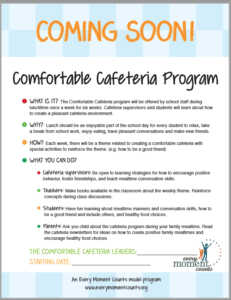 Action steps:
Action steps:
1. Start talking about it ... to everyone who will be involved in the program. Be enthusiastic! Let teachers, cafeteria supervisors, students and parents know when the program will begin;
2. Share information about the program. Give cafeteria supervisors and teachers a copy of the Comfortable Cafeteria Information Brief;
3. Encourage teachers to talk about the Comfortable Cafeteria program to their students a couple times during the weeks leading up to the program in order to generate student interest and enthusiasm. Give the teacher a copy of the black and white coloring sheets for the Comfortable Cafeteria (for primary students K -4th grades) or the Cool Cafe′ (5th -8th grade). This will give students a chance to learn about the program.
4. Share the Comfortable Cafeteria Marketing Flyer with the students to take home to their parents. Encourage students to tell their parents about the program.
We recommend meeting with the cafeteria supervisors and orienting them to the Comfortable Cafeteria program the week before the 6-week program begins. This will provide the cafeteria supervisors with foundation information about what will be taking place and how they will be involved.
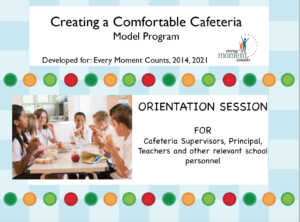 Orientation Action Steps:
Orientation Action Steps:
1) Schedule orientation session. Collaborate with the principal and cafeteria supervisors to schedule a 1 hour orientation session at a mutually agreed upon time. Since supervisors work during the middle of the school day, this session will most likely occur either before or after lunch. Make sure to include all relevant stakeholders if possible, including food service personnel and teachers that assist in the cafeteria. Encourage the principal to attend.
2) Orientation Session. The purpose is to share information about the vision, guiding principles, and weekly themes of the program using the Comfortable Cafeteria Power Point presentation. (another option is to send the PPT to the supervisors to review ahead of the meeting). Try and keep the presentation to about 15-20 minutes to ensure there is time to lead a discussion with the supervisors about what their greatest challenges and needs are in the cafeteria. Briefly summarize your Cafeteria Environmental Analysis findings. Begin to problem-solve solutions to challenges.
3) Review the behavioral expectations listed on the Cafeteria Poster and Cafeteria bookmark. In our experience implementing the program in multiple schools, issues related to noise and behavior seem to be common concerns.
Suggestion: Give the cafeteria supervisors a folder with a copy of the Power Point presentation, Comfortable Cafeteria Information Brief, and bookmark. Encourage them to use the folder to hold all of the subsequent handouts that will be provided each week.
Program Facilitators need to be effective coaches. The goal is to help the cafeteria supervisors be effective in and enjoy doing their jobs.
An effective coach:
- Develops a positive relationships with the supervisors based on trust
- Promotes two-way sharing of information
- Demonstrates positive unconditional regard for the cafeteria supervisors and food service personnel – they are experts about themselves and their experiences
- Is a facilitator of the change process involving problem-solving, exploring options, trying things out, working together and maintaining a positive attitude. You are in this together!
Specific instructions for how to implement the 6-week program are provided in the section below entitled, 'Just do it!: The Six Week Lesson Plans & Materials'.
For each week, a Lesson Plan for what to do along with collateral materials are provided.
Following the 6-week program, obtain feedback from the cafeteria supervisors, students, and principal about what went well and any lingering needs.
Action Steps:
1) Provide follow up coaching on an ongoing basis as needed. Visit the cafeteria routinely (e.g. every other week) to touch base with the cafeteria supervisors and find out how things are going. Observe interactions and informally solicit student input. Provide activity suggestions and support as needed. Maintain relationships.
2) Be creative! Consider developing a 'Cafeteria Committee' that will routinely meet to reflect on the lunch experience, challenges, and needs. The goal is to collaborate with cafeteria supervisors, teachers and students to do fun activities to sustain a comfortable cafeteria!
3) Foster sustainability. Encourage the principal to involve the OT or other program facilitators to help interview and orient new cafeteria supervisors. The purpose is to ensure that positive practices and supervision are sustained.
Now that the Comfortable Cafeteria program has been implemented with one grade level, replicating the program with other grades will require less time and effort. Because this program is designed to be a whole school initiative, it's important to implement it with as many grade levels as possible. With each replication, the vision, guiding principles and weekly themes will become a natural part of the cafeteria culture that will spread to all of the grades.
Action steps:
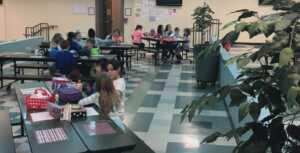 Repeat the program with another grade. The occupational therapist(s) and/or other program facilitators should meet to decide what grade level to implement the program in next and establish a timeline for when to start the program. Follow the '10 Steps to Success' to the extent needed. However, it is likely that the process can be streamlined the 2nd and 3rd times around!
Repeat the program with another grade. The occupational therapist(s) and/or other program facilitators should meet to decide what grade level to implement the program in next and establish a timeline for when to start the program. Follow the '10 Steps to Success' to the extent needed. However, it is likely that the process can be streamlined the 2nd and 3rd times around!
Help interview and orient new cafeteria supervisors on a yearly basis. Use the Comfortable Cafeteria PPT to orient new supervisors. Give them a folder with sample materials.
Share success stories! Spread and share the joy! Make sure to highlight successes during morning announcements and in school newsletters or on the school website.
Success story articles:
Food Management Magazine article about Lakewood City Schools implementation by Suzanne Scott, OTR/L
Cleveland Heights/University Heights newsletter article about implementation by Cindy Rakow, MS, OTR/L
Just do it! The 6 Week Lesson Plans & Materials
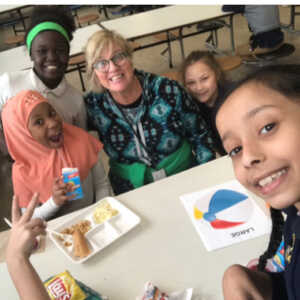 After you've read the 'Ten steps to success' and oriented the school cafeteria supervisors, you're ready to begin the program! For each week of the program, in the section below, you will obtain:
After you've read the 'Ten steps to success' and oriented the school cafeteria supervisors, you're ready to begin the program! For each week of the program, in the section below, you will obtain:
1) The weekly theme and goals
2) Weekly Lesson Plan with detailed instructions for what to do before and during the session
3) Links to the supporting materials, including bookmarks, posters, handouts, and reputable websites
Note: This program is geared for primary students, grades K through 4. You can use it as a guide for older students, but we suggest making the materials and activities developmentally appropriate for the students. For ideas on what to do with middle school students (grades 5 - 8), refer to the Cool Cafe′ toolkit below.
Suggestion: Feel free to be creative and implement the program in a way that uniquely 'fits' your setting and the age group. Modify activities as needed to make them developmentally appropriate.
Have fun implementing the program in your own school cafeteria! Spread the joy!
Theme: 'Kick off" the Comfortable Cafeteria program. Talk about how to create a comfortable cafeteria by emphasizing the 4 components: enjoyment of a meal, enjoyable social interaction, being responsible and respectful, and following directions.
Program facilitators: Make sure to say to students, 'this is your time to enjoy eating lunch and socializing with friends'!
Goals:
1) Cafeteria supervisors learn strategies for how to create a comfortable cafeteria, promote positive behavior and respond to challenges.
2) Students are oriented to the Comfortable Cafeteria program and learn about the 4 components as outlined on the Cafeteria Poster – Time to enjoy a meal, socialize with friends, be respectful & responsible, and follow directions.
Comfortable Cafeteria Week #1 Lesson Plan(download this handout)
Supporting materials (downloadable)
Every Moment Counts materials:
Comfortable Cafeteria Poster (copy, laminate and hang up either in poster size or 8.5 X 11")
Comfortable Cafeteria Bookmark (English; copy double-sided and cut into 4 bookmarks)
Comfortable Cafeteria Bookmark - Spanish
Comfortable Cafeteria Bookmark - Hmong
Comfortable Cafeteria Bookmark in black and white; use if you don't have access to a color printer
Comfortable Cafeteria Coloring Sheet (print on 8.5 X 11" in B&W)
Simple Strategies for Making the Cafeteria Comfortable (give to cafeteria supervisors during Week 1 or during the orientation)
Sound Cube – Use this template to make a Sound Cube to teach voice volume control
Picture Social Story of Cafeteria Expectations
Materials from other sources/authors:
1) Whatcom Farm to School resources - 'Strategies for Creating a Positive Cafeteria Environment' (highly recommended; 2-page handout)
 2) Incredible 5-Point Scale (Kari Dunn Buron). Learn more at www.5pointscale.com. Download scales for use to teach sound control. Also, refer to OCALI for information on the use of the 5-Point Scale.
2) Incredible 5-Point Scale (Kari Dunn Buron). Learn more at www.5pointscale.com. Download scales for use to teach sound control. Also, refer to OCALI for information on the use of the 5-Point Scale.
3) 20 Tried and True Classroom Strategies - for promoting positive behavior
4) Active Supervision: Classroom Checkup website and Head Start's information Head Start’s website; Active Supervision At-A-Glance handout
Theme: Fostering Friendship! How to be a good friend, make new friends, and include others.
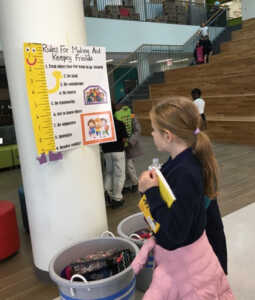 Goals:
Goals:
1) Students learn qualities of a good friend and how to make and be a friend.
2) Supervisors learn about friendship, how to foster friendships, and mealtime conversation tips.
Comfortable Cafeteria Week #2 Lesson Plan (download handout)
Supporting materials (downloadable)
Handouts for Supervisors & Teachers:
Friendship Development for Supervisors/Teachers
Fostering Friendships: Strategies for Supervisors
Peer Mediated Strategies (for fostering inclusion of students with disabilities)
Handout for Students:
Making Friends (suggestions for students)
Materials from other sources/authors:
Tony Attwood's website. Check out: Indices of Friendship Observation Schedule. Use this scale to assess a student's friendship skills.
Sunshine Parenting (Audrey Monke). Talking with kids about friendship. Sign up for her '10 Friendship Skills e-book' and 'Social Skills Checklist' on her website (www.sunshine-parenting.com)
Denworth, L. (2020). Friendship: The Evolution, Biology, and Extraordinary Power of Life's Fundamental Bond. (book) And her 2020 Atlantic article, The outside influence of your middle-school friends.
The ARC of Massachusetts. (2017). Making friends with and without disabilities in school: A toolkit for teachers, paraprofessionals, and parents. Excellent (free) toolkit for fostering inclusion and friendships. Once you get to this site, you will need to sign up to receive a free download of the toolkit.
Theme: Mealtime conversations. Time to welcome a special guest!
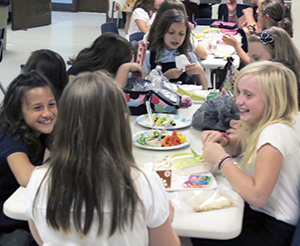 Lunch is a special time during the school day for students to relax and enjoy talking with friends. Engaging in pleasant mealtime conversations helps students feel good about their time in the cafeteria and offers them an opportunity to connect with friends and make new friends.
Lunch is a special time during the school day for students to relax and enjoy talking with friends. Engaging in pleasant mealtime conversations helps students feel good about their time in the cafeteria and offers them an opportunity to connect with friends and make new friends.
Goals:
- Students learn about how to have a positive mealtime conversation and practice conversation skills with each other and with the 'Special Guest'.
- Cafeteria Supervisors learn about how to model and teach mealtime conversation skills.
Comfortable Cafeteria Week #3 Lesson Plan (download handout)
Supporting materials (downloadable)
Every Moment Counts materials:
Special Guest Flyer Announcement
Coaching Conversation Tips for Supervisors
Conversation Starters for Students
Make the Conversation Cube for Week 3 or Week 4 - print out on cardstock or regular paper; form into cube; make 1 per table.
Conversation Starters: Refer to the Family Dinner Project website for age-appropriate conversation starters.
References: Snow, C. E., & Beals, D. E. (2006). Mealtime talk that supports literacy. New Directions for childhood and adolescent development, 111, 51-66. Scoville, A. M. (n.d.) Mealtime Matters. Forever Families. https://foreverfamilies.byu.edu/mealtime-matters University of Purdue Center for Families. Family Meals spell S-U-C-C-E-S-S (one page fact sheet on the importance of family mealtimes) https://www.purdue.edu/hhs/hdfs/cff/wp-content/uploads/2015/07/pfm_spellsuccessfactsheet.pdf
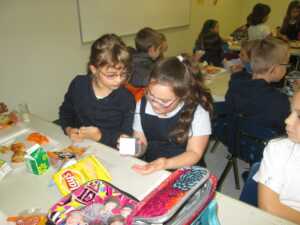 Theme: Including others. Respecting differences. It's time to toss up your table and 'Mix it up'. Toss up your lunch table to include others and celebrate differences. Continue to learn about and practice conversation skills with someone new. By sitting by someone new, students can make a new friend in the cafeteria!
Theme: Including others. Respecting differences. It's time to toss up your table and 'Mix it up'. Toss up your lunch table to include others and celebrate differences. Continue to learn about and practice conversation skills with someone new. By sitting by someone new, students can make a new friend in the cafeteria!
Goals:
- Students continue learn about how to have a positive mealtime conversation and have an opportunity to practice these skills with someone new. Students are randomly assigned to different tables.
- Cafeteria Supervisors continue to learn about how to model and teach mealtime conversation skills.
- Supervisors and students talk about the importance of respecting differences and including everyone.
Make: Conversation Cube - print out on cardstock or regular paper; form into cube; make 1 per table.
Comfortable Cafeteria Week #4 Lesson Plan (download handout)
Handouts for Supervisors & Teachers:
Coaching Conversation Tips for Supervisors (review from last week)
Handouts for Students:
Conversation Starters for Students (review from last week)
Friendship Golden Rules
 Conversation Starters: Refer to the Family Dinner Project website for age-appropriate conversation starters.
Conversation Starters: Refer to the Family Dinner Project website for age-appropriate conversation starters.
Other reference materials on respecting differences:
For ideas on how to help children learn how to respect one another, check out the Responsive Counselor’s webpage on ‘Respect’.
Theme: Students learn about sensory input in the cafeteria and its influence on how they feel; explore sensory preferences and aversions; and learn to respect sensory differences.
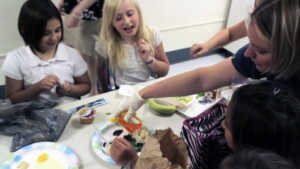 Eating lunch in the school cafeteria exposes students and supervisors to a variety of sensory input – the smell of food, the sound of many people talking, the sight of a lot of students in one room, and even the touch associated with handling foods. The focus of Week #5 is learning about sensory input and how it influences how we feel and function. Students reflect on personal likes and dislikes and become aware of respecting differences.
Eating lunch in the school cafeteria exposes students and supervisors to a variety of sensory input – the smell of food, the sound of many people talking, the sight of a lot of students in one room, and even the touch associated with handling foods. The focus of Week #5 is learning about sensory input and how it influences how we feel and function. Students reflect on personal likes and dislikes and become aware of respecting differences.
Goals:
- Students learn about the different types of sensory input in the cafeteria (auditory, olfactory/smell, visual, taste, touch) and reflect on their personal reactions.
- Cafeteria supervisors learn about the sensory aspects of cafeteria/lunch and learn how to tune-into and respond to students' individual responses.
Bring in: A variety of foods with varying textures and tastes.
Comfortable Cafeteria Week #5 Lesson Plan (download handout)
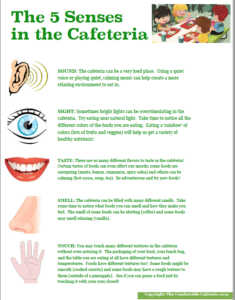 Handouts/Resources for Supervisors & Teachers:
Handouts/Resources for Supervisors & Teachers:
STAR Institute website. Handout: Do you know me? I am a sensational kid.
Handout for students:
The Five Senses developed by Jenny Negrey, MOT, OTR/L for Every Moment Counts.
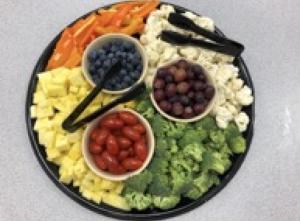 Theme: Students sample healthy fruits and vegetables and discuss why it is important to eat a variety of fresh foods.
Theme: Students sample healthy fruits and vegetables and discuss why it is important to eat a variety of fresh foods.
Goals:
1. Students have an opportunity to taste a variety of healthy fruits and vegetables.
2. Supervisors learn positive strategies for encouraging students to try healthy foods without being forceful or demanding.
Closure. Celebrate the last Comfortable Cafeteria session; commit to sustainability – keeping a comfortable cafeteria.
Bring in: A variety of fruits and vegetables to sample. Explore how the school or PTA can provide funds to purchase food.
Cafeteria Week #6 Lesson Plan (download handout)
Handouts for Supervisors & Teachers:
Encourage cafeteria supervisors and teachers to read - Bellows, L., & Anderson, J. (2006). Encouraging preschoolers to try new foods. Beyond the Journal: Young Children. California Preschool Instructional Network (www.cpin.us)
Visit the Nourish Interactive website for lots of age-appropriate information on healthy eating and free 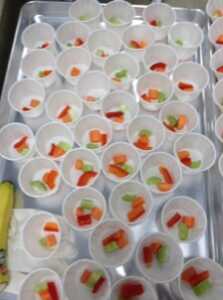 kid-friendly printables.
kid-friendly printables.
Kid's Food Group Chart (1-page handout)
Kid's Service Size Tips (1-page handout)
Read materials on Taste Testing in the cafeteria. There are many excellent resources available on the internet. Here are a few:
1) Host a taste test. (short web article with great tips). Action for Healthy Kids
2) Taste Test Toolkit: A Guide to Tasting Success. (12-page user-friendly toolkit) Vermont Harvest for the Month
3) Home Grown Taste Test Guide. (2015). (9 page guide) Wisconsin Department of Public Instruction.
Congratulations on completing the Comfortable Cafeteria program! Use the Every Moment Counts Pinterest site to implement a fun activity once per week to remind students about: being a good friend, engaging in enjoyable mealtime conversations, including others, and trying new healthy foods. Repeat the program with other grades. Consider orienting new cafeteria supervisors at the beginning of each school year.

Cool Cafe': Modifications for the Middle School Cafeteria
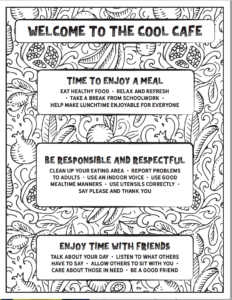 The Cool Cafe′ materials were developed to be used alongside the Comfortable Cafeteria program in order to consider the age-related social-emotional and lunchtime needs of middle school students (grades 5th through 8th).
The Cool Cafe′ materials were developed to be used alongside the Comfortable Cafeteria program in order to consider the age-related social-emotional and lunchtime needs of middle school students (grades 5th through 8th).
Guided by the weekly Comfortable Cafeteria themes, six newsletters with collateral materials (e.g. activities, information sheets) were developed to provide user-friendly information for school cafeteria supervisors on the specific developmental and health needs of middle school students. For example, students are encouraged to think about and discuss topics such as peer group challenges, mental health, dating and relationships, respecting differences, including others, healthy eating and body image.
The 6 Cool Cafe′ Newsletters and collateral materials are:
Week #1: Meeting the Needs of Middle School Students; Cool Cafe′ coloring sheet
Week #2: Friendship; Conversation jar; Friendship challenge
Week #3: Mealtime Manners and Conversations; Suggested Activities (conversation starters)
Week #4: Including Others and Respecting Differences
Week #5: Understanding our Sensory Needs; 5 Senses of the Cafeteria
Week #6: Promoting Healthy Eating
Download a pdf of the combined newsletters here.
Developed by: Bazyk, S., Demirjian, L., Ciolek, G., Emig, J., Koverman, J., & Assad, D. (2020).
Research Outcomes
A pretest post-test outcome study was used to obtain supervisor and student perceptions of their school cafeteria experiences following implementation of the Comfortable Cafeteria program.
Publication: Bazyk, S., Demirjian, L., Horvath, F., & Doxsey, L. (2018). The Comfortable Cafeteria program for promoting student participation and enjoyment: An outcome study. American Journal of Occupational Therapy, 74 (3), 1-9, https://doi.org/10.5014/ajot2018.02379
Title: The Comfortable Cafeteria program for promoting student participation and enjoyment: An outcome study.
Design: We used a mixed-methods design to evaluate student and cafeteria supervisor outcomes. A single-group pretest–posttest survey of students and supervisors (quantitative) was combined with qualitative analysis obtained from student and supervisor interviews (qualitative). Written reflections were obtained from the occupational therapists after program implementation.
Settings: 2 school districts in NE Ohio
Participants:
- 20 Cafeteria supervisors
- 168 of students (1st , 2nd , & 3rd graders)
Instruments:
- Supervisor survey included questions focusing on their enjoyment of supervising lunchtime and knowledge of how to supervise, find resources, encourage positive behavior, resolve conflict and interact positively with students.
- Students survey: A visual analog scale (VAS) was used to rate the students’ subjective experience of the cafeteria focusing on enjoyment, friendliness of supervisors and peers, and enjoyment of mealtime conversations.
Results of the mixed methods design found statistically significant improvements in pretest posttest ratings of participation in and enjoyment for students with low and mid-range scores at the outset. Cafeteria supervisor pretest posttest ratings demonstrated statistically significant improvements in perceptions of having the knowledge and skills to supervise and to encourage healthy eating. Qualitative findings suggest that students learned prosocial values (e.g. being kind, helping others), supervisors actively encouraged positive social interaction, and occupational therapy practitioners enjoyed implementing the Comfortable Cafeteria program and recognized positive supervisor and student changes as a result of integrating services in the cafeteria.
Conclusion: - This 6-week school-wide program provides OTs and other school personnel with an efficient & effective way to help all children enjoy their meal and social interaction – especially for those who experience lower levels of enjoyment. - By embedding OT services 1 day/week over 6 weeks, this program maximizes the impact of OT services by meeting the mealtime and social participation needs of all students with and without disabilities; - A combination of educational strategies, activity demonstration and coaching can be provided by OTs to help prepare cafeteria supervisors to promote positive social interaction, friendships, inclusion, and healthy eating. - Embedded activities emphasizing friendship & inclusion may help prevent social isolation for students who struggle making friends leading to higher levels of enjoyment.
Publication: Bazyk, S., Demirjian, L., Horvath, F., & Doxsey, L. (2018). The Comfortable Cafeteria program for promoting student participation and enjoyment: An outcome study. American Journal of Occupational Therapy, 74 (3), 1-9, https://doi.org/10.5014/ajot2018.02379

Jump to a Section
Downloadable Materials
Use the following materials to learn about, market, and implement the Comfortable Cafeteria program:
INFORMATION BRIEF: Inform others about the program. Download and share the Information Brief below. (2 pages)
Comfortable Cafeteria POSTER, BOOKMARKS, and COLORING SHEET (click on images below to download)
Comfortable Cafeteria Frequently Asked Questions (FAQs)
COMFY CAFE′: Modifications for Middle School Students
(6 Information Sheets)
Check it Out! Comfortable Cafeteria Video Clips!
Video #1: Here's what the cafeteria supervisors, students, and a speech therapist have to say about the Comfortable Cafeteria program (3 minutes) Click on image below to download.

Video #2: Here's what occupational therapists have to say about the Comfortable Cafeteria program (3 minutes)

Video #3: Here's what a principal has to say about the Comfortable Cafeteria program (2 minutes)

Orientation PPT: This power point presentation can be used to provide an orientation to the Comfortable Cafeteria program for cafeteria supervisors, teachers, and the principal. (no audio)

